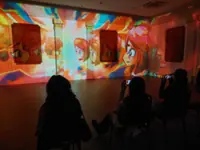The 'A Life In Shadows: The Story Of Wayang Kulit' exhibition offers a rare glimpse into the legacy of the late great Dalang Dollah Baju Merah, showcasing his storied wayang kulit puppets. Photo: The Star/Faihan Ghani
A funky green Wak Jamal brings the comedy, while the mystical Bapa Jin Gedung Gemita serves as your genie-like companion. Dewa Betara Guru rules over three worlds, Maharaja Rawana plays the villain, Dewa Daru inspires as the motivator, and Dewa Seru stands as the formidable guardian.
Meanwhile, a handful of worn and weathered shadow puppets bear the marks of time.





